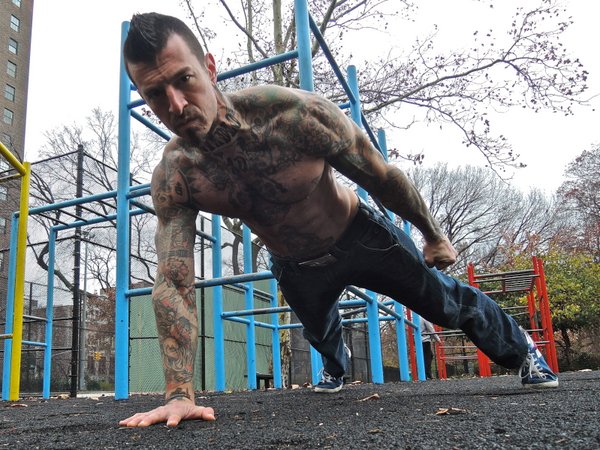
Okay. It’s the New Year. It’s 2015—that means another year just slipped by you.
Another ****ing year.
That vague image you had of your ideal self: of jacking up to a dangerous, bone-shattering level of strength, and bulking up some serious muscle…you got there yet? Huh? Or are you still running around on a low setting, chasing your own ass?
Big changes need to be made, stud. And big changes require big personal challenges. A rich dude I knew back in the Bay once told me that it was EASIER to set—and meet—the goal of making a million dollars, than setting and meeting a goal of making a hundred thousand dollars. Why? Cuz the bigger goal is more inspiring. It unleashes more psychic energy; causes you to truly marshal ALL your forces to meet the challenge. The same principle that holds true for money holds true for your body. A big, inspiring, challenging goal is more likely to be met than a small, flimsy, pathetic one. So here’s a goal for ya:
I want to help you put on 20 pounds of muscle in a single year: using only bodyweight training.
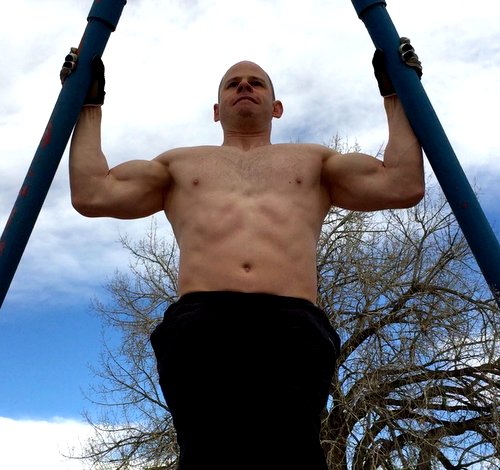
Now, if you love training and that ain’t a goal to jack you up—you’re probably dead already. Twenty pounds of dense, solid muscle is an awe-inspiring amount of beef, and would totally revolutionize your body. Forget what you mighta seen on bodybuilding sites or magazines, where guys talk about putting on ridiculous amounts like fifty pounds in a year. That’s real rare, and when it does happen it is purely the result of huge amounts of steroids and other chemical poisons: it is mostly water, and what isn’t water is fake, artificial tissue that’ll disappear (taking extra with it) when the drugs are discontinued. That’s madness to me: if you want to look big using dumbass tricks, just stuff some goddam Kleenex in your sleeves. (In fact, modern bodybuilders are actually doing the equivalent of this. Google “synthol abuse” if you feel like laughing at the mentally challenged.)
What will twenty pounds of REAL muscle look like on you? Imagine a big, juicy quarter pounder burger patty. Now, remember that a quarter pounder burger is its raw weight: and that patty is at least a third bigger before cooked up. Now imagine four of these big, raw patties squashed together. That big, meaty lump is pretty much what a pound of muscle looks like. So imagine twenty of those lumps (that’s eighty large raw burgers).
It’s quite an amount, no? If you could plaster your torso, arms and legs with all that meat, you’d appear much, much bigger and more intimidating. (Remember, if you count bones, organs, skin and the rest, the average guy only has about forty pounds of lean muscle on his body anyway.)
And as for strength? Damn, son—if you really want to level up your raw power, getting diesel is a real good way to do it. Yep, there are some real pansy huge bodybuilders out there, and there are some tiny guys who can lift like Superman. But as a general rule, there is a direct correlation between muscle and strength. That’s why powerlifters and Olympic lifters move up through weight classes throughout their careers: as they gain strength, they gain lean muscle tissue. Plus, you’re not gonna be pumping out reps on silly machines, right? You are gonna be using the ultimate functional training tool: your body. You WILL become alpha-strong as a consequence of training for this goal.
How to really do it: six keys to success
You are probably expecting a routine here, right?
In truth, it’s very, very tough to work hard on just one routine for a year. Most athletes will get stale and bored, and quit. Thinking “programs” is not enough. Putting on the “Diesel 20” is a big ask—it’s kinda like going to war. Exercises and routines are your weapons and equipment. In war, the tactics you use are way more important than your weapons. We’ll talk programs a little later—let’s absorb the tactics first. Here are SIX Alpha-Building tactics to keep you on the straight and narrow:
- Joints first
If you are going into a year of hard training, you gotta be conditioned to it first. The job of a beginner—no matter what age they are—is to learn the correct calisthenics movement patterns, build basic strength, and condition their joints. If beginners launch into tough regimes designed to build maximum muscle, they will only end up hurt and frustrated. If you are a beginner and want a great starter routine for the New Year, I wrote one here just for you.
- Work the basics.
Despite what you might believe, tons of muscle is NOT built by working with dozens of exercises, working with isolation-type moves, or by working each muscle head “from every angle”. This might (or might not) be a method for putting the finishing touches on a physique that already carries plenty of beef—for actually building mass, its worse than useless. A better tactic is to structure your training around a handful of basic, compound movement-types, used progressively. I favor the “Big Six”: pullups, bodyweight squats, handstand pushups, bridges, leg raises, and pushups. (Some folks might choose to include dips as part of the pushup family.)
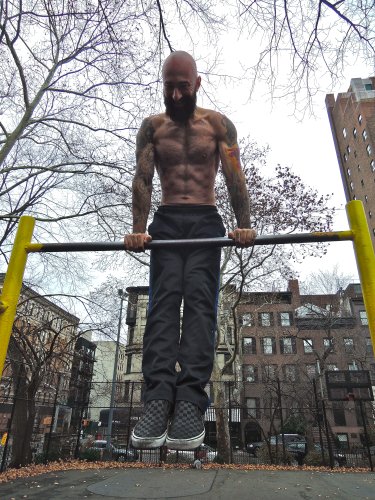
dips can be an excellent upper-body builder.
Note that “structuring your training around” these six does NOT mean you are limited to six exercises. The Big Six are families of exercises: so when you are doing “pullups”, you might actually want to do two types of vertical pull plus a horizontal pull to work all your back muscles: three exercises, but they all come under the “pullup” banner. As long as you stick to the basics and work progressively, this is a good way to work everything to the max.
You can add other bodyweight work, certainly for the lower body: explosive jumps and plyo work goes well with squats, as does sprinting training. (Hill or stair sprints build more muscle on the legs than you might imagine: many UFC fighters actually favor this kind of work over barbell squats.)
Beyond this, if you want to throw in some different stuff into your sessions—maybe isolation movements or static exercises—sure you can. But use these things sparingly, as add-ons, rather than the backbone of your program.
- Mix low AND high reps.
High reps or low reps for maximum muscle gain? If you read my article, The Ten Commandments of Calisthenics Mass (Commandment X), then you know that you need BOTH. For upper-body, it’s a great idea to begin your sessions by using very hard pulling and pushing exercises which limit you to low reps. If you want, you can use more sets than usual. One useful method is to shoot for 10-15 reps over as many sets as it takes.
It doesn’t matter what exercise you use—dips, pullups, pushups, levers, handstand pushups, whatever—just use low reps for your primary push and pull movement, and constantly try to move up to harder and harder techniques. For the rest of the pulling/pushing exercises of your workout, you should shoot for higher reps, attempting to really drain the muscles. In the old days, this used to be called the “heavy/light” system. There are alternative equivalent methods, but this combination works very well over the long term.
You can use this approach for legs, too, but since the lower body has adapted to carrying you around all day, you can usually grow well using just higher reps.
- Sets and reps?
As I said above, if you are working with very hard exercises, where you can only get low (1-5) reps, you can use more sets to reach your rep goals. (If you can only do four strict pullups, for example, you might set a workout rep goal of ten reps, and do a set of four, a set of three, and three singles—or whatever you can manage.)
If you are pushing hard on muscle-building, higher rep sets (8-20) stick to one or two sets and just give it your all. (Extending your set—by changing grip, style, range-on-motion, speed or position—doesn’t count as a new set. It’s all one set, baby!) That’s miles better than just plugging away. Sure, for legs you can get away with adding more sets than this, but always emphasize quality over quantity.
- Hit it hard or go home.
If you want to transform yourself this year, work ****ing hard when you train. How hard? Hard enough to improve—it ALL comes down to this. “Improving” doesn’t mean “jumping to stuff that’s too difficult”. It means finding a baseline you find manageable but tough, and consistently improving form, adding a rep here or there, or making minor technical progressions. These all add up over the year to huge changes.
I’m not a generally huge fan of training to “failure” for most workouts. But the reality is that the harder you push yourself, the better your body adapts, to cope with the perceived effort. Eight reps is better than six reps. Fourteen reps is better than ten reps. If you are fired up and committed to gaining a LOT of muscle in the near future, you need to push yourself more than you might in regular strength training sessions.
- Stay away from the weights.
To those of you versed in modern fitness “culture”, this sounds nuts. Sacrilege, even. You gotta hit that bench, those heavy squats, or you can’t grow, bro! Sure. That’s why gymnasts are some of the most muscular natural athletes on the planet.

In the REAL world, using weights makes training TOO EASY. That’s why most gym-trained folks never change. Any fat weakling can do bench presses or machine curls. But strict dips? One-leg squats? Hanging levers? One-arm pushups? Only for REAL athletes.
Bodyweight also keeps you honest. It’s simple to bulk up 20 pounds of fat and go do some deadlifts and convince yourself it’s “all muscle”. But when you are struggling to add reps to your pullups, you know the truth from the lies pretty damn quick.
Programs, Paulie?
Okay—that’s the tactics. What about the program?
Well, I can’t give you a program. That changes over a year. (For sure, the exercises you use MUST change, as you grow in power and mass.) There are plenty of programs you can apply these tactics to in Convict Conditioning, Raising the Bar and C-MASS.
Like I said, your program should ideally be based around six basic components (which are distilled into the Big Six). Pullup variations, bodyweight squats and leg work, bridges, handstand work, leg raises/midsection and pushups. They key is to work these six families hard. What does “hard” look like? Here’s a sample intermediate routine, containing just two workouts, cycled with a day off between each. The exercises may change if you are not this strong, but the flavor is there:
WORKOUT 1: Pullups, Squats, Bridges
Pullups
Everyone loves pullups! You warm up with two sets of five regular two-arm pullups and some hanging stretches, just to get everything loose. After that’s it’s archer pullups—an exercise you find pretty tough. You want to get ten cumulative reps in today: it doesn’t matter how many sets it takes. You begin with your weakest side, and manage to grind out four good reps. You repeat that on your stronger side, then get three reps on both sides. You finish with another set of two (both sides) and a single (both sides), making ten reps (4, 3, 2, 1). Not quite failure, but tough, stimulating work—you’re going for eleven reps next time, champ!
Not done yet, though. After some shoulder circling, you head back to the bar to finish off with regular, two-arm pullups. Your lats and biceps are so shot that strict, deep reps are out of the question now: so you only go ¾ of the way down, and swing yourself up. One set of nine of these, and there’s no point in doing any more vertical work: your lats are flash fried.
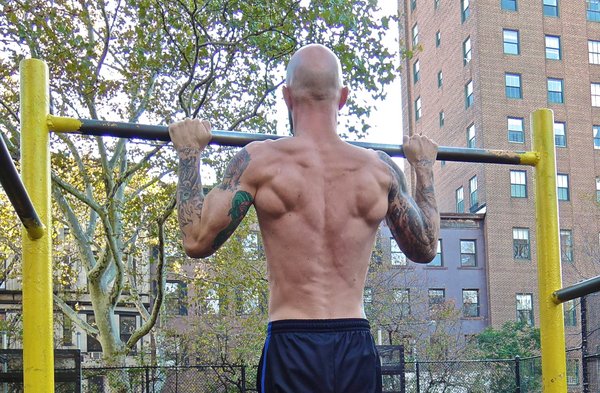
Your upper-back and traps could use some more training, right? So it’s back to everybody’s favorite, horizontal pulls. You set yourself under a low bar and pull yourself up until your chest touches, forcing your shoulder-blade muscles to contract almost painfully, even from rep one. A strict set of eight, followed by a set of seven leaves your upper-back tissues pumped and burning as hell.
By now, your entire upper-back has had a great workout—front-to-back, side-to-side. You are a Spartan though, and want to finish off with a little treat for your grip—hanging grip holds. To help work the entire hand, you throw a couple towels over the bar, turning a tough exercise into a real bastard. Your forearms are pretty thrashed already, so you can barely last a few seconds each hold—three sets and yer hands are cramping, with your forearms feeling so hot, you want to plunge them into ice water. Great work. You are doing something right! Thankfully, your arms can take a break now. Legs are up next.
Squats
After a warm-up of jogging on the spot and jackknife squats, it’s time for the perfect neural primer if you want big legs: explosive jumps. Three sets following the rules and progressions I set out in Convict Conditioning 3 (released soon!) and BANG—it’s suddenly time for squats.
Perfect one-leg squats are a little tough for the rep range you’re shooting for, so you start with a version of assisted squats, using a doorframe to help pull yourself up. You go tough on yourself, though—each rep is slow, strict, momentum-free, and with as little help as possible. Ten strict reps per leg, for three sets, leave your quadriceps feeling like they’ve been surgically removed, dipped in battery acid, then sewn back in.
But you need more squats—for motor patterning and conditioning. (Don’t worry, those big leg muscles can take it.) So you work with deep, strict, perfect two leg squats—two sets of fifty reps leave those legs pumped and blitzed beyond belief. Not done yet though—you head outside for some sprints. (I’m betting you have a stretch of road. Somewhere.) You set a point around a hundred meters away, and hit it. At first it feels like you’re running through Jell-o, but you grit your teeth and somehow adapt. Five rounds of sprints with a minute in-between leaves those legs shot and shaky. You ever seen a sprinter’s legs, kid?
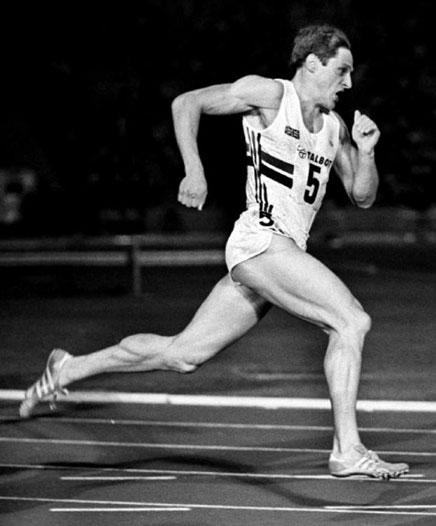
Bridges
Back indoors and though you yearn to crash on the couch, you still have another exercise to go: bridges. Everything is warm now, so you head straight to bridge pushups: fifteen reps seem easy, so you stretch out and switch to gecko bridge pushups—one arm, one leg. Only for champions, this. You are shaking and trembling, but manage four reps apiece. It doesn’t feel like enough, so you go back to regular bridge pushups, and bang out a set of twelve: each rep with a three second pause, tensing at the top. Just to bulk up those back-legs, you finish with two sets of straight bridges—twenty-five and eighteen reps leave your hamstrings (and triceps) aflame.
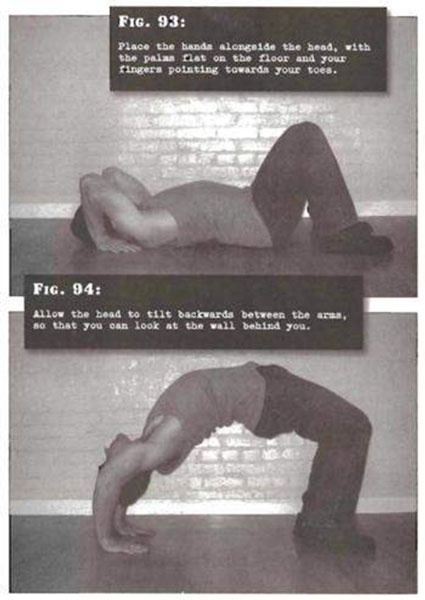
By now, it’s time to call it a day. But there’s a nagging feeling in the back of your mind: you suspect that you worked your legs so damn hard—all the squats, jumps and running—that you couldn’t give your spinal muscles all they deserved during the bridges. Your legs gave out first. Sure, you gave them a good workout, but “good” won’t build the Diesel 20, right? So you rock up to the overhead bar again, jump up and spin round into a back lever. Yeah, it’d be ideal to lever up and down, but your body is so brutalized now, just holding the lever is an achievement. You hold it ramrod stiff for three seconds—spinal muscles like steel pythons…five seconds…body shaking…eight seconds, and down. You give yourself a goal of thirty seconds total, holding the back lever: it takes seven ruthless, cumulative sets to manage it. By the end of it, you are sweating and exhausted, and your spinal muscles are thrashed to hell.
Do you do any more for your legs and back? Any squats, deadlifts, leg curls, hacks, adductor band moves? NO! Not because you don’t want to, because you can’t. Your muscles are worked to the max!
Forget what the fools tell you that you can’t build muscle with calisthenics. If you can train like this once or twice a week for a year, you will revolutionize yourself. This stuff would add mass to a pencil! Go have a steak and a good night’s sleep—you earned it.
WORKOUT 2: Handstand pushups, leg raises, pushups
It’s 48 hours, ten hours sleep and several quality meals since your last workout: but your legs are still a little stiff. Must be time to hit it again with workout 2! We did pullups, squats and bridges last time: this time it’s handstand work, midsection and pushups. Mostly upper-body. Your legs shouldn’t have to work too hard.
Handstand pushups
A good warm-up is always a great idea before shoulder work. So you start with shoulder rolling, active stretches, plus a few handstands against the wall. That gets some blood in there. Time to hit handstand pushups: for your first set, you bust out a strict set of six—not too shabby. Two minutes rest and you’re back on it—five reps. Maybe you could have got six, but it’s not wise to push too hard when your skull is hovering above the ground, right? You still want more, so you add sets rather than doing lots of reps all at once. Another set of 3, then a final perfect single rep, and you call it a day (that’s 15 reps: 6, 5, 3, 1). On that final single rep you hold your arms locked out for a total of about twelve seconds—seems like forever. You don’t quite crumple to the floor after this, but you ain’t far off.
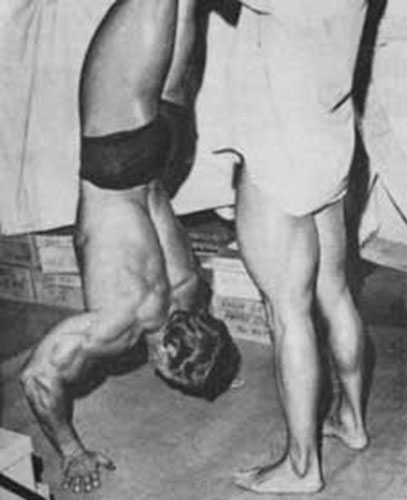
the legendary Frank Zane spots him.
You can feel the deep stimulation in the deltoids and triceps as you wander around, shaking out your wrists and arms. How can your shoulders and arms NOT grow after a beating like this? Hell, your whole damn upper-body feels like it’s had a workout!
Leg raises
Need to stretch out those compressed torso and shoulder muscles—after a break and a sip of water, you head off to the horizontal bar.
Your body is already warm, so after a couple sets of light, stretchy, knee raises, it’s time for the real stuff: strict hanging leg raises. With your legs as stiff as ramrods and using zero momentum, you bust out a set of eighteen. On the next set you only get six reps before you need to start swinging and cheating, but fight your way to eleven anyway. Two sets and your abs, waist and hips are toast.
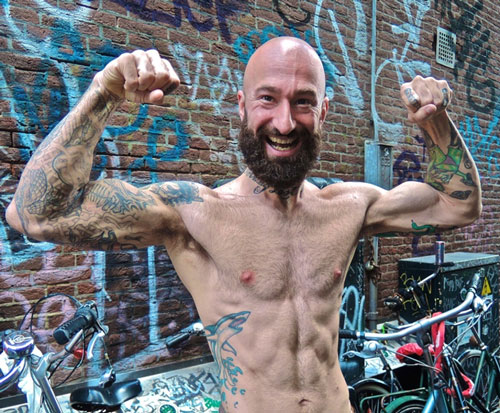
You drop down and walk to the other side of the room, to give your grip a bit of a rest, then you’re back—this time for hanging knee raises. These should seem easy after the straight-leg stuff, but your abs are tired: you can manage one really, really tough, messy set of twenty-one. Your hanging strength is spent now, so you head to the floor. You get on your back, not for a rest, but to work on some lying leg raises. One set of twelve strict, wheezing reps and you are nearly done. There’s a little gas left in those abs, so you quickly hook your feet under the couch and move to fast sit-ups. Just ten reps in, your abs are ready for suicide. By fifteen, “fast” is out the window, and you are gulping breaths on the floor between reps. You shoot for thirty, but twenty three is your absolute limit today—not because you quit, but because your stomach muscles do. How do you know you’re done? You can’t even get up for a full minute—your abs won’t respond. So you lie down and get your breath until you can face the next movement.
Pushups
You take a few minutes to walk off the pain in your belly, stretching a little to let the blood and waste products in your tight abs dissipate, then it’s back to your true love: the floor. A couple of easy warm up sets of pushups, then you’re into the real stuff. Let’s work the arms and shoulders with close pushups—one strict, slow set of twelve leaves your pushing muscles hot, and your triceps swollen like balloons. So we repeat the feat! Or try—you manage an agonizing-but-strict ten reps. You could not do more close pushups if you tried. So you place your hands a few inches apart, and the shift allows you another three pushups. Then you move a few inches apart again—two more. By now your upper-body is screaming in pain, and you are huffing like the Little Engine That Could. But you are a warrior, and there is more in you. So you switch to regular pushups, and manage to grind out five okay reps—with a little body English. This last set has lasted twenty reps—but WHAT a set it was. For sanity’s sake, you take a ten second breather, shaking out your arms and shoulders. Still not done, you get back into the pushup position and pump out some partials—nine half reps, six quarter reps, and finally about a dozen “pulse” reps: just bumping up and down, to squeeze the last bit of juice from your muscles. If the floor was a 500lbs barbell, it wouldn’t be any easier to push!
By now, the triceps and shoulders are blown to bits. But the pecs—after a three minute rest they got a little bit left in the tank. You set up two chairs a little way apart, and place your palms of the seats for stretch pushups, setting your feet up on a box at hip height to make things even tougher. Ten reps and your chest muscles are in agony. You manage eleven. But instead of crashing down, you pop your feet down on the floor to improve your leverage and continue. You manage another four reps only, your chest screaming at you the whole way. You’re toast.
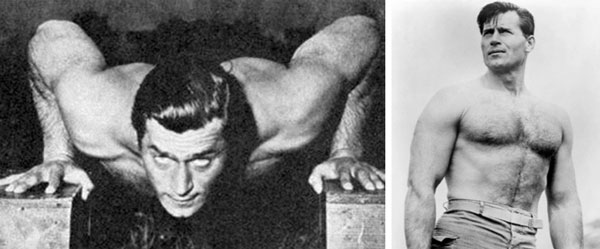
It takes you five minutes of rest before you feel ready to hit the shower. Another killer workout in the bank—but look on the bright side. You got another 48 hours to rest before going back to workout 1 and kicking yourself in the ass again.
Got the idea?
Gentlemen, it’s training like this that builds SERIOUS MUSCLE. It’s not easy. It’s not really fun. But if you can train like this for a year you will look like all those guys you always dreamed of looking like. I’m not saying you should do this workout—you can use any workouts you like—I’m just trying to give you a taste of the kind of hard-ass, focused training that will ramp up your muscle mass quickly.
Another point is that you need to—always—vary the exercises you are using to reflect your strength and ability. For most people, the exercises in the above workouts, with those rep levels, would be too tough. For some hard cases, these exercises would be too easy. The exercises you use will change as you get stronger, fairly quickly: the athlete performing these exercises would “outgrow” them fairly soon, as he moves to harder and harder stuff over the year. (How do you “move to harder and harder stuff”? You meet rep goals on the exercises you are doing, then find ways to make ‘em a little harder. You got this thing, right?)
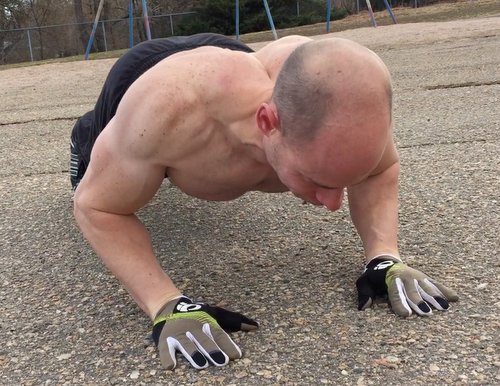
Just Do It
If you are really up for this challenge—Beta to Alpha in twelve short months—one final piece of advice. Keep it secret. I don’t believe this modern bullshit that you should shout your goals to as many folks as possible. There is magic in secrecy, in knowing something nobody else does. Social media is one reason so few folks get in shape these days—they expend all their mental energy talking about their goals, and leave none for the goals themselves.
Shoot me a comment with questions or ideas—but don’t promise me you are gonna do it. Promise yourself. If you really want to go for this, get weighed, take a photo of your physique, and come back in one year to show me how awesome you got. I WILL publish it, and you WILL get famous.
I believe in you, kid.
A million thanks to the greatest calisthenics trainers on earth, Al and Danny Kavadlo, for providing most of the photos. Find Al at AlKavadlo.com and Danny at DannyTheTrainer.com. It was also an honor to be able to use shots of the Fit Rebel himself, Matt Schifferle. This guy is a master bodyweight bodybuilder, and really understands the science like nobody else in the world. Please check out his site, RedDeltaProject.com.
***
Paul “Coach” Wade is the author of Convict Conditioning, Convict Conditioning Volume 2, the Convict Conditioning Ultimate Bodyweight Training Log, and five Convict Conditioning DVD and manual programs. Click here for more information about the Convict Conditioning DVDs and books available for purchase from Dragon Door Publications.